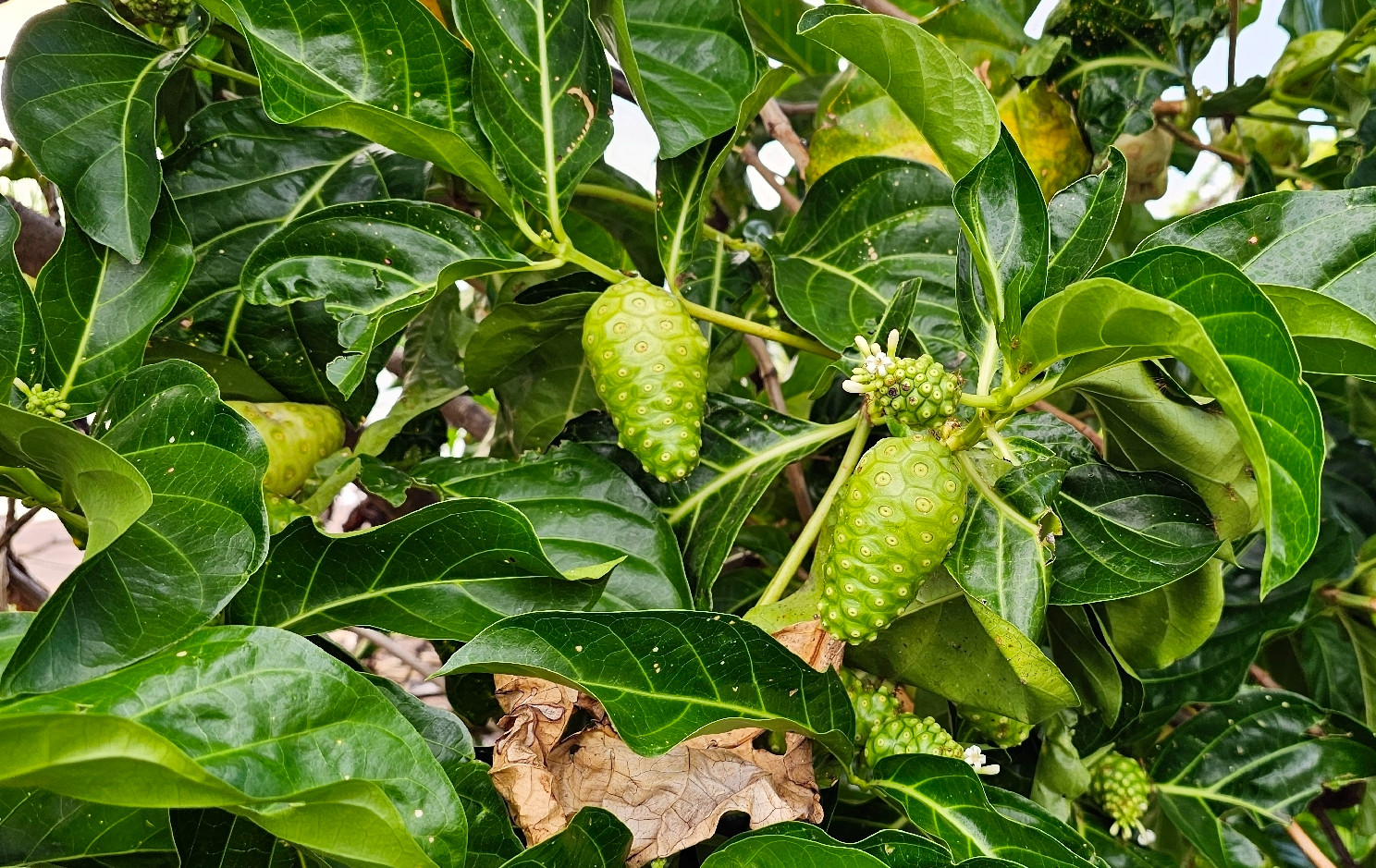Morinda citrifolia L. - syn.Morinda bracteata Roxb., Morinda littoralis Blanco; Morinda macrophylla Desf. - Rubiaceae
noni (hawaiian), mengkudu (tahitian), Indian mulberry, cheesefruit, Noni (-Baum), Indischer Maulbeerbaum
Evergreen shrub or tree, 3-10m high, native to Queensland (Australia), naturalized on coastal regions of the Indian Ocean and Pacific (Hawaii, Oceania); leaves ovate, glossy; flowers white, fragrant, tubular; fruit irregularly ovoid.
„The fruit of this species are edible (though not particularly palatable) and said to have medicinal and/or tonic value; they are sold by natural food vendors under the name 'noni' or 'nona'. This species is increasingly widely cultivated…“
http://www.efloras.org/florataxon.aspx?flora_id=2&taxon_id=200022155
„Much of the interest in commercial production of noni products can be traced to an outrageous publication in the Pacific Tropical Botanical Garden Bulletin. [Heinicke 1985] This unreferenced and authoritatively written
report appearing in an horticultural bulletin, proposes the presence of an active compound in M.citrifolia
known as xeronine, which is said to be derived from a precursor, proxeronine. It is interesting that this seemingly biochemical report is published in the bulletin of a botanical garden, because it may have been better published in the Journal of Irreproducible Results.“
[From Polynesian healers to health food stores: changing perspectives of Morinda citrifolia (Rubiaceae)., McClatchey, W., Integrative cancer therapies, Vol.1(2), 2002, 110-120] PDF
„Its 'grenade like' shaped fruits are green until maturity, when they rapidly turn to a light yellow and then a translucent white. The fruit has an unsound taste and a soapy smell being ripe. Noni is sold for various nutritional and health benefits, which are mostly anecdotal with limited scientific evidence… The pattern of anthracene derivatives (“HPTLC fingerprint”) or of volatile components (“HS-SPME/GC/MS fingerprint”) are more specific for Noni and also correspond to the aroma and flavour of the fruit.“
[Authentication of noni (Morinda citrifolia) juice., Lachenmeier, K., Mußhoff, F., Madea, B., Reusch, H., Lachenmeier, D.W., Deutsche Lebensmittelrundschau, Vol.102(2), 2006, 58]
PDF
„The fruit juice has bad smell or possesses a rancid cheesy flavor and odor due to its content of carboxylic acids.“
[Study of coating tablet extract noni fruit (Morinda citrifolia, L.) with maltodextrin as a subcoating material., Anwar, E., Arsyadi, B.K., J.Med.Sci, 7(5), 2007, 762-768]
„From unripe fruit, the two principal components were octanoic acid (89.7 %) and hexanoic acid (3.6 %). From ripe fruits there was less acid; octanoic acid (60.2 %) and hexanoic acid (16.3 %). There were a series of 3-methylbut-3-en-1-yl esters (butyrate, hexanoate, octanoate and decanoate) in amounts up to 4 % in the ripe fruits. Also present were a series of methyl ester of these acids. Terpenes were virtually absent from the oils. Both the ripe and unripe fruit volatiles showed similar antimicrobial activities, when tested with five microbes signaling that the active volatile components were probably the major alkanoic acids.“
[Chemistry and Antimicrobial Activity of the Essential Oils from Ripe and Unripe fruits of the Fijian Morinda citrifolia (noni/kura) Rubiaceae., Brophy, J., Devi, R., Ali, S., Rao, D., Sotheeswaran, S., Journal of Essential Oil Bearing Plants, Vol.11(6), 2008, 598-602]
„The Panel concludes that 'Morinda citrifolia' (Noni) fruit puree and concentrate as novel food ingredients’ under the specified conditions are considered safe for the general population. However the Panel considers that the increasing number of case reports might indicate that some individuals have a particular sensitivity for hepatotoxic effects to noni fruit products.“
[Opinion on the safety of Tahitian Noni® ‘Morinda citrifolia (noni) fruit puree and concentrate’ as a novel food ingredient, Scientific Opinion of the Panel on Dietetic Products, Nutrition and Allergies (Question No EFSA-Q-2007-181), March 2009 ] PDF
37 compounds were detected in the methylene chloride extract of noni pulp headspace collected on Porapak Q trap. „The peak area percentage was used to indicate the relative concentration of each compound. They were identified as seven alcohols, corresponding to 63.3% of the volatile compounds, 20 esters (26.9%), three ketones (7.4%), six acids (1.2%), and one aldehyde. The major compounds, based on the relative amount, were 3-methyl-3-buten-1-ol (54.83%), methyl hexanoate (13.04%), methyl butanoate (8.1%), 2-heptanone (6.86%), and benzyl alcohol (5.2%).“
[Evaluation of noni (Morinda citrifolia) volatile profile by dynamic headspace and gas chromatography-mass spectrometry., Sousa, A., Souza Neto, M.A., Garruti, D.D.S., Sousa, J., Brito, E.S.D., Food Science and Technology (Campinas), Vol.30(3), 2010, 641-644] PDF
„Due to noni maturation, octanoic acid, decanoic acid and (E)-2-nonenal decreased their concentrations, while some esters (methyl hexanoate, methyl octanoate, ethyl octanoate and methyl (E)-4-decenoate), which their fruity odor notes, increased their contents. Two unsaturated esters, reported for the first time in this fruit, 3-methyl-3-buten-1-yl hexanoate and 3-methyl-3-buten-1-yl octanoate, significantly decreased their concentration in the ripe to over-ripe fruits… In general, although terpenes are present in small quantities in both maturity stages, their contribution to the fruit's flavor could be considerable, as in the case of limonene and linalool, which were found to possess intense citrus and flower-like odors. Interestingly, three sulphur compounds were found for the first time in noni fruit, e.g. dimethyl disulfide, dimethyl trisulfide and 3-(methylthio)-1-propanol.“
[Volatile compounds in noni (Morinda citrifolia L.) at two ripening stages., Pino, J. A., Márquez, E., Quijano, C.E., Castro, D., Food Science and Technology (Campinas), Vol.30(1), 2010, 183-187]
PDF

Blanco, M., Flora de Filipinas, t.52 (1875) plantgenera.org
 Morinda citrifolia, Nightcliff, Australia (2025) © Jodie Zerna CC BY-SA 4.0 inaturalist.org
Morinda citrifolia, Nightcliff, Australia (2025) © Jodie Zerna CC BY-SA 4.0 inaturalist.org
